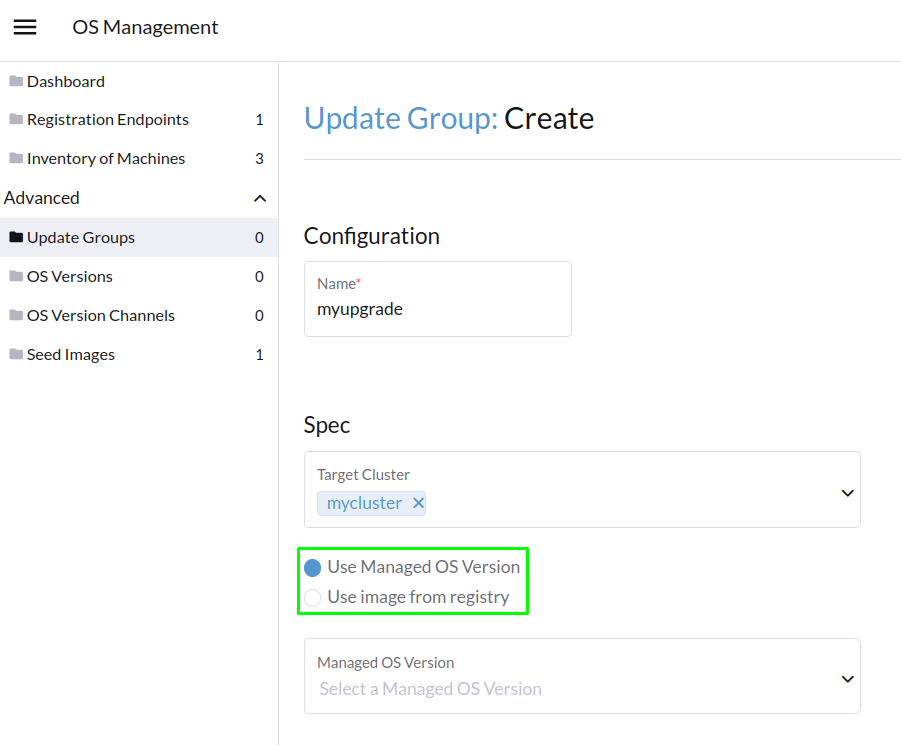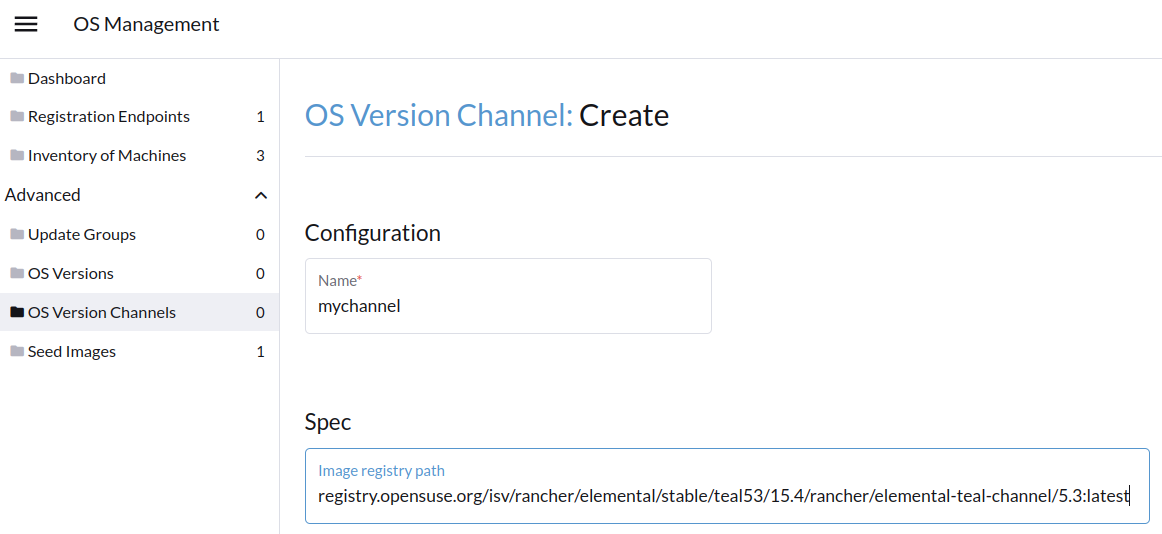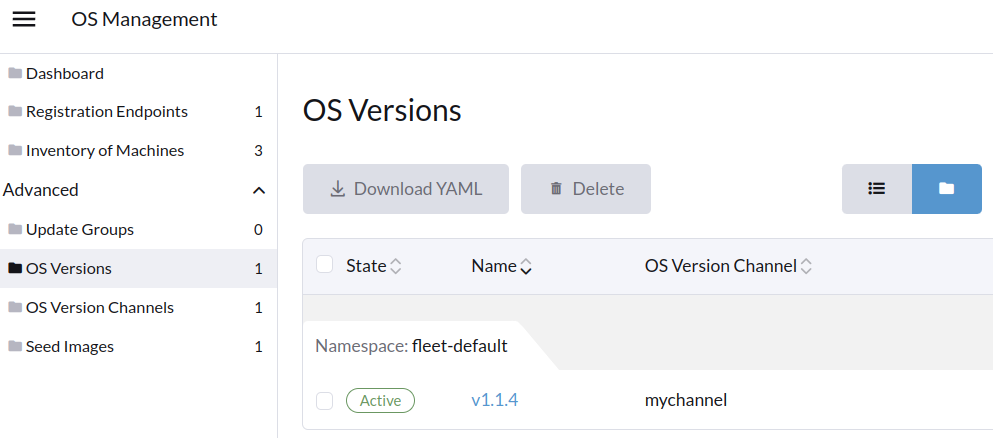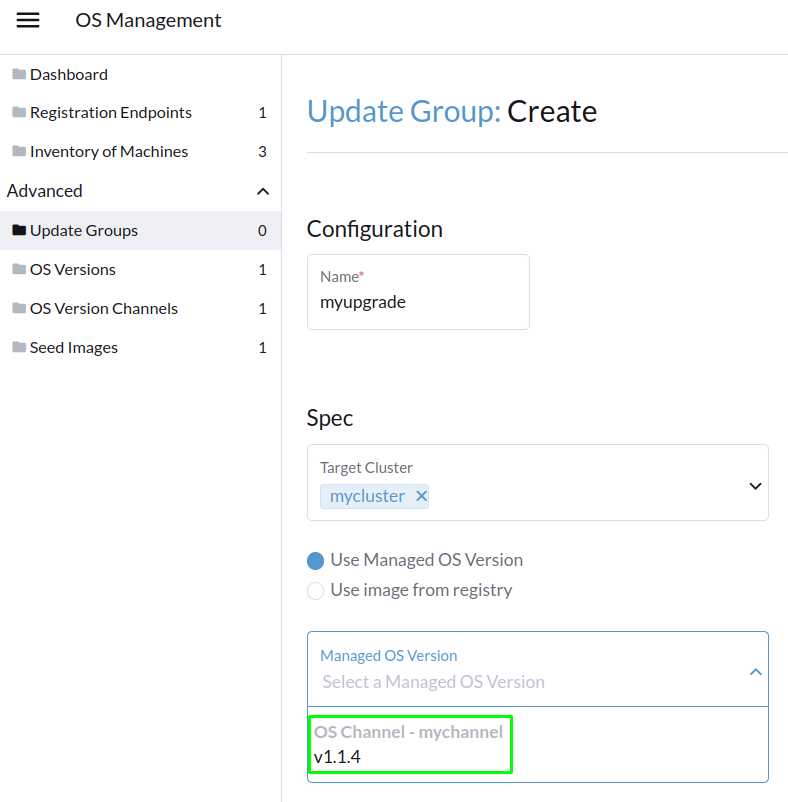Upgrade
All components in Elemental are managed using Kubernetes. Below is how to use Kubernetes approaches to upgrade the components.
Elemental Teal node upgrade
Elemental Teal is upgraded with the Elemental Operator. Refer to the Elemental Operator documentation for complete information.
Upgrade can be achieve either with CLI or UI:
Upgrade via command line interface
There are two ways of selecting nodes for upgrading. Via a cluster target, which will match ALL nodes in a cluster that matches our selector or via node selector, which will match nodes based on the node labels. Node selector allows us to be more targeted with the upgrade while cluster selector just selects all the nodes in a matched cluster.
Updating an existing ManagedOSImage is ineffective.
Once a version upgrade is completed on all targeted clusters, you can safely delete the ManagedOSImage and create a new one to trigger a new upgrade.
From version 1.5.0 of the Elemental Operator, the ManagedOSImage is an editable resource and can be used to reconcile a desired OS image or image version to all targeted clusters.
- With 'clusterTarget'
- With nodeSelector
- With FORCE flag
You can target nodes for an upgrade via a clusterTarget by setting it to the cluster name that you want to upgrade.
All nodes in a cluster that matches that name will match and be upgraded.
apiVersion: elemental.cattle.io/v1beta1
kind: ManagedOSImage
metadata:
name: my-upgrade
namespace: fleet-default
spec:
# Set to the new Elemental version you would like to upgrade to or track the latest tag
osImage: "registry.suse.com/suse/sle-micro/5.5:latest"
clusterTargets:
- clusterName: my-cluster
You can target nodes for an upgrade via a nodeSelector by setting it to the label and value that you want to match.
Any nodes containing that key with the value will match and be upgraded.
apiVersion: elemental.cattle.io/v1beta1
kind: ManagedOSImage
metadata:
name: my-upgrade
namespace: fleet-default
spec:
# Set to the new Elemental version you would like to upgrade to
osImage: "registry.suse.com/suse/sle-micro/5.5:latest"
clusterTargets:
- clusterName: my-cluster
nodeSelector:
matchLabels:
kubernetes.io/hostname: my-machine
When upgrading to an older version or the same version that is already running the upgrade-procedure will be skipped.
It is possible to force upgrades to older versions by setting the FORCE environment variable as shown below.
apiVersion: elemental.cattle.io/v1beta1
kind: ManagedOSImage
metadata:
name: my-upgrade
namespace: fleet-default
spec:
# Set to the new Elemental version you would like to upgrade to
osImage: "registry.suse.com/suse/sle-micro/5.5:latest"
clusterTargets:
- clusterName: my-cluster
upgradeContainer:
envs:
- name: FORCE
value: "true"
Selecting source for upgrade
- Via 'osImage'
- Via 'ManagedOSVersion'
Just specify an OCI image on the osImage field
apiVersion: elemental.cattle.io/v1beta1
kind: ManagedOSImage
metadata:
name: my-upgrade
namespace: fleet-default
spec:
# Set to the new Elemental version you would like to upgrade to or track the latest tag
osImage: "registry.suse.com/suse/sle-micro/5.5:latest"
clusterTargets:
- clusterName: my-cluster
In this case we use the auto populated ManagedOSVersion resources to set the wanted managedOSVersionName field.
See section Managing available versions to understand how the ManagedOSVersion are managed.
apiVersion: elemental.cattle.io/v1beta1
kind: ManagedOSImage
metadata:
name: my-upgrade
namespace: fleet-default
spec:
# Set to the new ManagedOSVersion you would like to upgrade to
managedOSVersionName: v0.1.0-alpha22-amd64
clusterTargets:
- clusterName: my-cluster
If both osImage and ManagedOSVersion are defined in the same ManagedOSImage be aware that osImage takes precedence.
Managing available versions
An ManagedOSVersionChannel resource can be created in a Kubernetes cluster where the Elemental operator is installed to synchronize available versions for upgrades.
It has a syncer in order to generate ManagedOSVersion automatically. Currently, we provide a json syncer and a custom one.
- Json syncer
- Custom syncer
This syncer will fetch a json from url and parse it into valid ManagedOSVersion resources.
apiVersion: elemental.cattle.io/v1beta1
kind: ManagedOSVersionChannel
metadata:
name: elemental-versions
namespace: fleet-default
spec:
options:
URI: "https://raw.githubusercontent.com/rancher/elemental-docs/main/examples/upgrade/versions.json"
Timeout: "1m"
type: json
A custom syncer allows more flexibility on how to gather ManagedOSVersion by allowing custom commands with custom images.
This type of syncer allows to run a given command with arguments and env vars in a custom image and output a json file to /data/output.
The generated data is then automounted by the syncer and then parsed so it can gather create the proper versions.
The only requirement to make your own custom syncer is to make it output a json file to /data/output and keep the correct json structure.
Elemental project provides an Elemental Teal channel to list all ManagedOSVersions released as a custom syncer.
See the Elemental Teal channel resource definition below:
apiVersion: elemental.cattle.io/v1beta1
kind: ManagedOSVersionChannel
metadata:
name: elemental-channel
namespace: fleet-default
spec:
options:
image: registry.suse.com/rancher/elemental-channel:latest
type: custom
In both cases the file that the operator expects to parse is a json file with the versions on it as follows
[
{
"metadata": {
"name": "my-flavor-v0.1.0"
},
"spec": {
"version": "v0.1.0",
"type": "container",
"metadata": {
"upgradeImage": "foo/bar-os:v0.1.0-myflavor",
"displayName": "Foo Bar OS - My Flavor"
}
}
},
{
"metadata": {
"name": "my-flavor-v0.1.0-iso"
},
"spec": {
"version": "v0.1.0",
"type": "iso",
"metadata": {
"uri": "foo/bar-iso:v0.1.0-myflavor",
"displayName": "Foo Bar ISO - My Flavor"
}
}
}
]
Upgrade via user interface
To upgrade via the UI, you have to go in the Elemental Advanced menu, then click on Update Groups.
Choose a name, select clusters to target and choose between the two upgrade ways:

- Via Managed OS Version
- Via Image from registry
In this case, a OS Version Channels is used to auto populated OS Versions resources.
The channel bellow is provide by us but you can bring your own channel as well.
See section Managing available versions to understand how the ManagedOSVersion are managed.

After a short syncing time, you will see your OS Versions appears in the OS Versions menu.

Finally, you can select the OS Versions when you create your Upgrade Group according to the following screenshot:

Just specify an OCI image on the Image path field to upgrade to:

Click on the Create button to start the upgrade process, if you have multiple nodes, the upgrade will be done sequentially node by node.